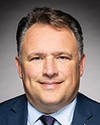Thank you very much, Mr. Chair and honourable members of the Standing Committee on Canadian Heritage.
My name is Margaret Huber, and I have the honour of acting as the Chief of Protocol of Canada. The Office of Protocol is located within the Department of Foreign Affairs and International Trade, and I report directly to the Associate Deputy Minister of Foreign Affairs. While housed within Foreign Affairs, the Office of Protocol provides protocol support and advice to the Governor General and the Prime Minister, as well as the DFAIT portfolio ministers. The Office of Protocol also provides guidance to other federal departments, as well as to provincial and territorial offices of protocol.
The chief of protocol is considered to be the most senior protocol officer for high-level international visits to Canada and outgoing state, official, and working visits, as well as for overall issues relating to the entitlements and special status granted to the foreign diplomatic community in Canada. That includes a number of international organizations, such as the International Civil Aviation Organization in Montreal.
The Office of Protocol manages and facilitates the presence and work of the foreign diplomatic community in Canada and across Canada, since we're a very large country. This includes about 8,000 diplomats and their families. We support official international visits and events of the Governor General, as well as official visits and events, both abroad and in Canada, of the Prime Minister and the ministers of the Foreign Affairs and International Trade portfolio.
Two divisions within the Office of Protocol may be of particular interest to this standing committee. The first is the official events division, headed by my colleague with me today, Charles Reeves. This division delivers DFAIT's official events management program in support of incoming official and working visits hosted by the Prime Minister and portfolio ministers and their official visits abroad.
This division delivers auxiliary, logistical, and courtesy services in respect of certain official events of the Governor General here and abroad. It also fulfills an overall advisory role regarding official events and hospitality for the federal, provincial, and municipal governments. This division has also played a supporting role for the Department of Canadian Heritage in the delivery of events for the incoming royal visits, such as last year's visit of Their Royal Highnesses the Duke and Duchess of Cambridge. It will again be playing such a supporting role in the upcoming visit to Canada of Their Royal Highnesses the Prince of Wales and the Duchess of Cornwall.
The official events division has also provided support in the delivery of state funerals, most recently the state funeral for Jack Layton in 2011.
The second division that I believe may be of interest to the standing committee is the official visits division, also represented here today by Andrea Hudson, the deputy director. This division coordinates visits to Canada by official guests of the Governor General, the Prime Minister, and DFAIT portfolio ministers, funded from the government hospitality allotment with which we are entrusted. For each visit, this group ensures coordination with Rideau Hall, the Prime Minister's Office, the Privy Council Office, the RCMP, Health Canada, Veterans Affairs Canada, the Department of National Defence, parliamentary protocol, provincial and/or territorial protocol offices, foreign missions in Canada, Canadian missions abroad, and various DFAIT divisions. As you can see, we're great believers in collaboration and coordination and working together.
As part of the oversight for incoming visits to Canada, this division defines standards of treatment for state, official, working, and private visits of heads of state, heads of government, ministers, and guests of government. Standards of treatment provide general guidelines for a visit in areas such as accommodation, local transportation, security, gifts, hospitality, and ceremonial elements.
I would also like to provide clarification with regard to visit designations. For a state visit of a foreign head of state to Canada, ceremonial elements may include an official welcome by the Governor General, military honours at Government House or the Canada Reception Centre, usually depending on the time of the arrival, a tree-planting ceremony at Government House, an official welcome on Parliament Hill, a 21-gun salute, wreath laying at the National War Memorial or the Peacekeeping Monument, a state dinner or luncheon, flag street lining in Ottawa, and red carpet for arrival and departure.
An official visit is the highest visit designation for a visit by a foreign head of government to Canada, as opposed to head of state. Ceremonial elements are similar to a state visit. Ceremonial elements can include an official welcome by a federal representative, military honours, official welcome on Parliament Hill, a 19-gun salute, wreath laying at the National War Memorial or Peacekeeping Monument, some form of official hospitality, flag street lining in Ottawa, and red carpet for arrival or departure. There is, as I mentioned, a certain degree of flexibility, depending on the circumstances and the wishes of our guest.
For all ceremonial elements, protocol works in close collaboration with other departments to work out the details of each event. In some cases, protocol leads, while for other events, we rely on the expertise of colleagues to lead on event logistics, for example, events on the Hill in which we work very closely with parliamentary protocol.
The official visits division also coordinates official travel abroad of the Governor General, the Prime Minister, and portfolio ministers, funded from the international conference allotment.
For 2011, the official visits division coordinated a total of 168 high-level visits, 132 outgoing and 36 incoming. Notable visitors to Canada included the President of Colombia, the President of the Czech Republic, the Prime Minister of the U.K., the Prime Minister of Kuwait, the Crown Prince of Brunei, and of course we currently are enjoying the visit of the President of Israel.
In addition, the official visits division manages the Canada Reception Centre, which includes an airport terminal lounge at the Ottawa airport and hangar 11 for dedicated aircraft. The hangar is used by our Prime Minister and Governor General for domestic and international flights, as well as by international high-level dignitaries visiting Ottawa. For example, President Peres arrived on a dedicated aircraft and will also be departing on a dedicated aircraft.
Lastly, this group that Andrea is representing also delivers the national airport courtesy program, intended to facilitate security clearances and greeting privileges for high-level foreign dignitaries transiting through or visiting Canada. As you can imagine, this group is especially busy during periods around the UN General Assembly, major conferences taking place in North America, or on other occasions. Each such clearance does require extensive coordination with my colleagues at the Canada Border Services Agency, Transport Canada, the Canadian Air Transport Security Authority, Citizenship and Immigration Canada, and airport security authorities across Canada.
As my CBSA colleague reminded me earlier today, every airport is different, so we do make sure that the appropriate facilities are in place.
In 2011, approximately 800 courtesy clearances were facilitated in this way by the official visits division.
I would be pleased to answer any questions that the honourable committee members may have. Thank you for listening and for inviting me to be here today.




